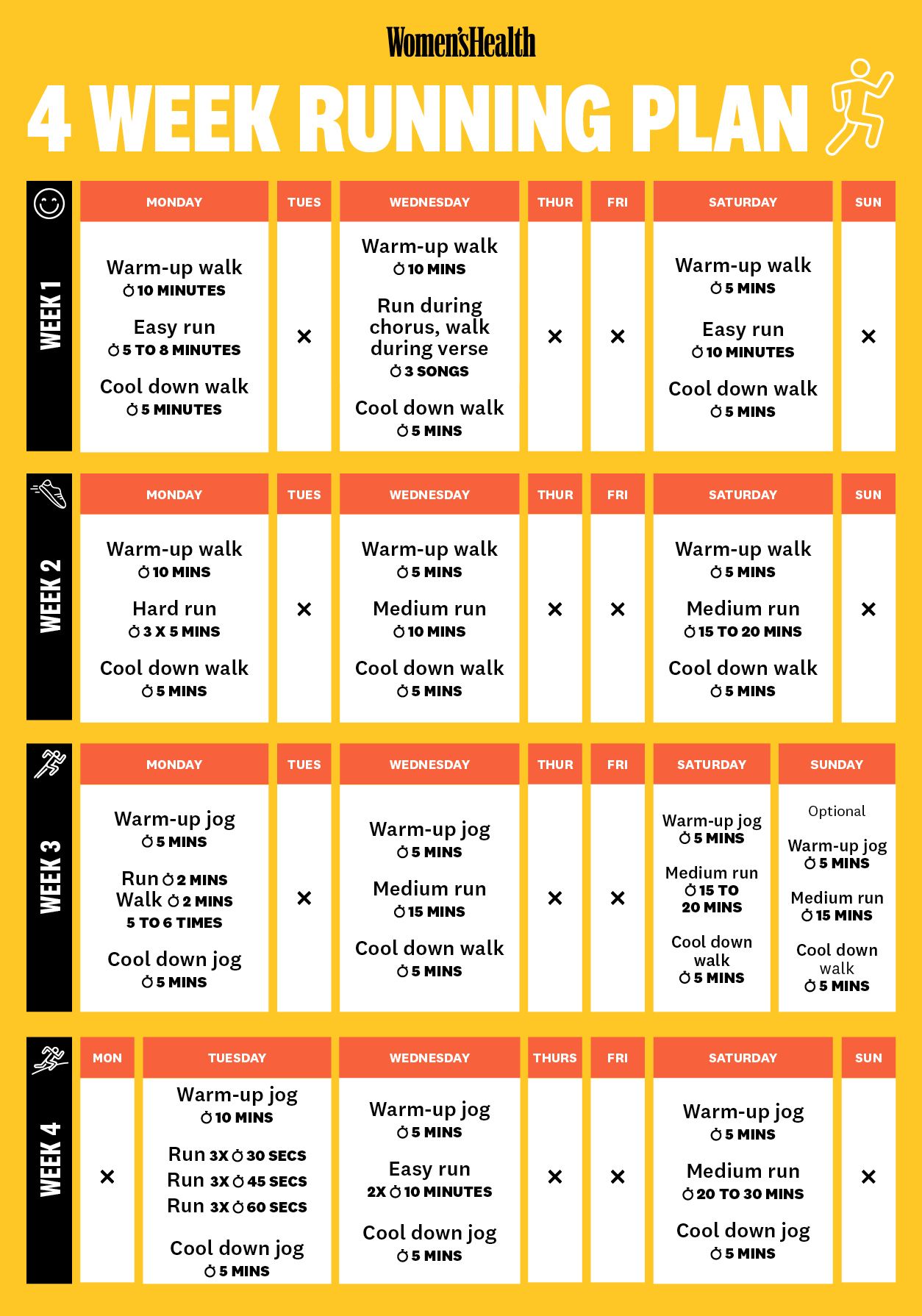
Ask any runner how they got started running, and they’ll make it sound so simple. And, in theory, it is: Grab a pair of sneakers, throw on some shorts, and get moving. But just like that final term paper you had to write your senior year of college, starting anything from scratch can feel super intimidating.
Here’s the thing: Running (even just a little bit) can bring you gobs of health benefits. A mere 30 minutes of running per week for three weeks can boost sleep quality, mood, and concentration during the day, according to a study in the Journal of Adolescent Health. And for those of you who have been using the “ugh, it’s hard on my knees!” excuse, you can throw that out the window. One 2016 study found that running may in fact benefit the joint, changing the biochemical environment inside the knee in ways that could help keep it working smoothly.
Still nervous? I hear you—but don’t stress. I’ve connected with some top run coaches to get you all the information you need to start (and stay!) moving. From the right gear and best-practice tips to a 4-week, beginner’s running plan, you’ll be lacing up and perfecting your “pick up the pace” workout playlist in no time.
First things first, gear up
“Wearing the right gear is one of many ways to help make your run more comfortable and less stressful,” says Becs Gentry, Peloton Tread instructor and Nike running ambassador.



The good news? Today’s gear is created with a runner’s comfort in mind, such as sweat-wicking, cooling or heating, wind protection, chafe-minimizing, blister control…the list goes on. All of these features help you get from start to finish more calm and collected.
Gentry’s biggest equipment advice for newbies? Purchase based on fit and functionality before fashion. “Look at the product closely and think about what your body does when you run,” she says. “Seams running down the back of your knee could cause chafing, since you’re constantly flexing and extending that area of your body.”
Focus on form
Just like with any sort of workout, it’s important to get the form down before going out and, say, signing up for a 5K. Running correctly is crucial for improving overall speed and reducing the risk of injury, says Karli Alvino, a coach at Mile High Run Club in New York City.
Alvino suggests that all beginner runners set up a time for an initial form assessment with a local run coach, where you can learn the basics and assure you’re prepared for successful, safe miles. But if that’s not accessible to you, consider Alvino’s form-friendly, best-practices to keep in mind when it comes to pounding pavement.
Learn how this Olympic medalist completely transformed her running career:
Keep a few tips in the back of your mind.
You’re almost ready to get moving. Before you take your first stride, keep these helpful expert tips in mind:
Follow this 4-week plan
Okay, you’re ready to move. I teamed up with Nike+ Run Coach Jes Woods to create a 4-week running plan, perfect for newbies.
“In just four weeks, we’ll be introducing all the tools needed in your running toolkit: recovery, speed, strength, and endurance,” says Woods. “These will not only make you a better runner, but they will also help keep things interesting.”
Follow this beginner running plan, and scroll down to read more about Woods’ recommended goals for each week.
 Jewelyn Butron
Jewelyn Butron
Week 1 goal: Just get out there and have fun!
This week, let’s get comfortable moving and making running part of your weekly routine. Running may not feel natural (or even fun) at first, so consistency is key early on. Music can make getting after it easier. We’ll incorporate it in two of your runs this week.
Day 1: Easy Run
- 10 minutes: Walking warm-up
- 5 to 8 minutes: Run at comfortable pace (easy)
- 5 minutes: Walking cool-down
Woods says: “Find comfortable pace with an emphasis on comfortable. This means it’s conversational. If you find yourself unable to sing along to your music, slow it down.”
Day 2: Rest
Day 3: Speed Intervals (Fartlek)
- 10 minutes: Walking warm-up
- Repeat for three songs: Push the pace during the chorus, and walk (or easy jog) to recover during each verse
- 5 minutes: Walking cool-down
Woods says: “It’s okay to start getting breathless during these speed play surges. Unlike your easy run earlier this week, if you find yourself unable to sing along to the chorus, you’re doing it right!”
Day 4: Rest
Day 5: Rest
Day 6: Long Run
- 5 minutes: Walking warm-up
- 10 minutes: Continuous running, easy pace
- 5 minutes: Walking cool-down
Woods says: “This should feel like your easy run, but longer.”
Day 7: Rest
Week 2 goal: Get stronger
This week, we’re introducing a strength workout by finding your threshold pace. Threshold pace may sound daunting and super scientific, but you can get pretty close to it simply by feel and by staying in tune with your breath. It should feel like a 7 out of 10 effort, in terms of perceived exertion. Your threshold pace is the magical tipping point between aerobic (conversational) and anaerobic (breathless). If you’re still listening to music on your run, the threshold pace breath test is to find a pace where you can sing just one quick sentence of your song, then need a couple of breaths before singing another quick sentence.
Day 8: Strength Workout
- 10 minutes: Walking warm-up
- 3 times 5 minutes: Running at hard pace
- 5 minutes: Walking cool-down
Day 9: Rest
Day 10: Recovery Run
- 5 minutes: Walking warm-up
- 10 minutes: Continuous running at conversational pace (medium)
- 5 minutes: Walking cool-down
Day 11: Rest
Day 12: Rest
Day 13: Long Run
- 5 minutes: Walking warm-up
- 15 to 20 minutes: Continuous running at conversational pace (medium)
- 5 minutes: Walking cool-down
Day 14: Rest
Week 3 goal: Pick up the pace
This week, we’re working on making your fast faster. When you do this, you’ll notice all of your paces will start to get faster. For example, your easy pace will start to get faster while you’re still able to hold a conversation.
Day 15: Speed Intervals
- 5 minutes: Jogging warm-up
- 5 to 6 times: 2 minutes on (running), 2 minutes off (jogging or walking)
- 5 minutes: Jog cool-down
Woods says: “When you’re running, gradually build speed until you’re breathless. Then slow until your breathing is under control, an easy jog or walk.”
Day 16: Rest
Day 17: Recovery Run
- 5 minutes: Walking warm-up
- 15 minutes: Continuous running at conversational pace (medium)
- 5 minutes: Walking cool-down
Day 18: Rest
Day 19: Rest
Day 20: Long Run
- 5 minutes: Walking warm-up
- 15 to 20 minutes: Continuous running at conversational pace (medium)
- 5 minutes: Walking cool-down
Day 21: Recovery Run (optional)
- 5 minutes: Jogging warm-up
- 15 minutes: Continuous running at conversational pace (medium)
- 5 minutes: Walking cool-down
Week 4 goal: Go longer
Going farther isn’t just about building physical endurance, but building mental stamina as well. Now is not the time to panic. Grab a friend, find a crew, look for a local running group. Long runs are always easier (and more fun) with friends.
Day 22: Rest
Day 23: Hill Run
- 10 minutes: Jogging warm-up
- 3 times 30 seconds (short hill), 3 x 45 seconds (medium hill), 3 x 60 seconds (long hill)
- 5 minutes: Jogging cool-down
Woods says: “Hills are speed work in disguise. You should run the hills with the same intense effort as last week, using an easy jog or walk downhill to recover.”
Day 24: Recovery Run
- 5 minutes: Walking warm-up
- 2 x 10 minutes: Easy pace run (2-minute walk recovery in between, if needed)
- 5 minutes: Jogging cool-down
Day 25: Rest
Day 26: Rest
Day 27: Long Run
- 5 minutes: Jogging warm-up
- 20 to 30 minutes: Continuous running with your run buddy or crew (medium)
- 5 minutes: Jogging cool down
Day 28: Rest
Day 29: Rest
Day 30: Recovery Run
- 5 minutes: Jogging warm-up
- 15 minutes: Running at easy pace
And at the end of week four: “You’ve made it!” says Woods. “This is your victory lap. You now have all the tools needed to make running a seamless part of your lifestyle.””
Source: Read Full Article